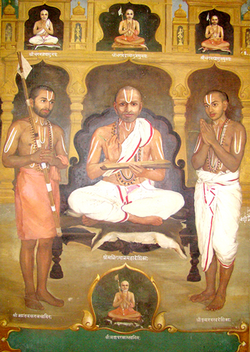Philosophy:Shatadushani
| Part of a series on | |
| Hindu philosophy | |
|---|---|
 | |
| Orthodox | |
|
|
|
| Heterodox | |
|
|
|
The Shatadushani (Sanskrit: शतदूषणी, romanized: Śatadūṣaṇī) is a polemical treatise[1] written by the Hindu philosopher Vedanta Desika in the 12th century CE.[2] Literally translating to "one hundred defects", the Shatadushani is a refutation of the hundred central tenets of the philosophy of Advaita.[3][4]
Description
Though the title of the work suggests hundred refutations, only 66 of them are now available. It establishes the validity of the Vishishtadvaita philosophy of Ramanuja against the Advaita of Adi Shankara.[5]
It is said that at the age of around 50 or 55, Vedanta Desika was invited by his disciples at Srirangam to engage in a polemical debate with a group of Advaitins from North India. The arguments made in the form of refutations against these men are said to be the content of this work.[6]
Surendranath Dasgupta, in his magnum opus The history of Indian Philosophy, has allotted almost 40 pages for this particular book of Vedanta Desika in the third volume of the series.
R. Kesava Aiyangar, a senior advocate of the Supreme Court of India has written an exhaustive introduction to this work in English for the book titled Vedanta Desika's Shatadushani by Srivatsankacharya.
Umamaheshvara's Virodha-varudhini (or Virodha-varuthini) discusses contradictions in Shatadushani and other Vishishtadvaita works.[7]
References
- ↑ University, Vijaya Ramaswamy, Jawaharlal Nehru (2007-05-22) (in en). Historical Dictionary of the Tamils. Scarecrow Press. pp. 301. ISBN 978-0-8108-6445-0. https://books.google.com/books?id=H4q0DHGMcjEC&pg=PA301.
- ↑ Tripathi, Radhavallabh (2021-02-10) (in en). Vāda in Theory and Practice: Studies in Debates, Dialogues and Discussions in Indian Intellectual Discourses. DK Printworld (P) Ltd. pp. 103. ISBN 978-81-246-1080-0. https://books.google.com/books?id=ay0dEAAAQBAJ&pg=PT103.
- ↑ Landis, Dan; Bhawuk, Dharm P. S. (2020-08-27) (in en). The Cambridge Handbook of Intercultural Training. Cambridge University Press. pp. 924. ISBN 978-1-108-84646-2. https://books.google.com/books?id=QpcJEAAAQBAJ&pg=PT924.
- ↑ Chari, S. M. Srinivasa (1988) (in en). Fundamentals of Visista. Motilal Banarsidass Publ.. pp. 8. ISBN 978-81-208-0266-7. https://books.google.com/books?id=un1i5icdpdoC&pg=PA8.
- ↑ Farooqui, Salma Ahmed (2011) (in en). A Comprehensive History of Medieval India: Twelfth to the Mid-eighteenth Century. Pearson Education India. pp. 143. ISBN 978-81-317-3202-1. https://books.google.com/books?id=sxhAtCflwOMC&pg=PA143.
- ↑ Sudarshan, M. K. (2022-04-23) (in en). The Nondescript God: "Abstraction or Paragon?". Blue Rose Publishers. pp. 11. https://books.google.com/books?id=tXlsEAAAQBAJ&pg=PP11.
- ↑ Surendranath Dasgupta (1991). A History of Indian Philosophy. 3. Motilal Banarsidass. pp. 395–396. ISBN 9788120804142. https://books.google.com/books?id=jI2PUAa8B8oC.
 |


